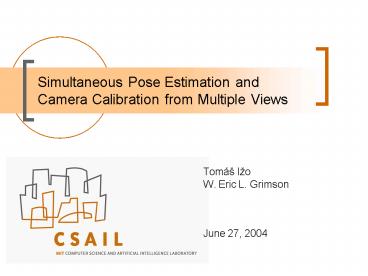Simultaneous Pose Estimation and Camera Calibration from Multiple Views - PowerPoint PPT Presentation
1 / 21
Title:
Simultaneous Pose Estimation and Camera Calibration from Multiple Views
Description:
States no longer directly observable: hidden states. Hidden states generate visible symbols with some probability density over the ... – PowerPoint PPT presentation
Number of Views:137
Avg rating:3.0/5.0
Title: Simultaneous Pose Estimation and Camera Calibration from Multiple Views
1
Simultaneous Pose Estimation and Camera
Calibration from Multiple Views
- Tomá Io
- W. Eric L. Grimson
- June 27, 2004
2
Motivation
- Easy problem for humans
- Take image of walking human
- Shape a 3D stick figure to correspond to the pose
in image - Applications
- Intelligent rooms
- Gait analysis
3
Problem
- Input
- Video sequences of walking person from multiple
cameras - Cameras are synchronized and have overlapping
fields - Cameras not calibrated
- Output
- Estimated camera pose (positions) with respect to
direction of motion - Estimated 3D body pose in each frame
4
Approach
- Model human walking motion
- Model appearance by clustering examples
- Model dynamics using an HMM
- Fit model to input
- Obtain silhouettes using background subtraction
- Find best matching appearance cluster for each
silhouette - Estimate camera position from best matching
clusters - Estimate pose using HMM
5
System Overview
6
Motion Appearance Model
- Camera Pose Space (L)
- Space of allowed camera positions around person
- Set of pairs (?,f)
- Body Pose Space (B)
- Walking cycle discretized into 20 phases
- Sample from space BxL
- 17,280 examples
- Examples consist of silhouette 2D joint
locations - Cluster examples using EM
- Cluster on 2D joint locations
7
Clustering Examples Using EM
- Assume gaussian cluster densities
- EM update equations
8
Clustering algorithm
- Select number of clusters N
- Initialize ? using k-means
- Randomly pick N examples to serve as initial
cluster means µi - Assign example xi to cluster j whenever
- Recompute cluster means and iterate until
stopping criterion met - Compute priors and covariance matrices
- Iterate using EM update equations until stopping
criterion is met
9
Number of Clusters
- Scatter criteria
- Within-scatter
- Between-scatter
- Evaluating within-scatter
10
Clustering Results
Single cluster (EM with N100)
Cluster means in the camera pose space
11
Comparing binary silhouettes and continuous
cluster means
- Take cluster mean sc and binary silhouette sb
- Register silhouettes
- Fit ellipse to each and align major axes
- Isotropic scaling to achieve equal height
- Compute distance
12
Hidden Markov Models
- Markov Model
- Set of states with associated priors
- Transition probabilities
- Hidden Markov Model
- Added set of visible symbols
- States no longer directly observable hidden
states - Hidden states generate visible symbols with some
probability density over the set of visible
symbols
13
HMM for walking motion
- Input
- walking phase estimate per frame and camera
- ? observations
- Output
- sequence of phase estimates
- ? hidden states
- Structure
- Cyclical, feed-forward
- Problems
- Input is noisy
- Opposite phases have similar appearance
14
System Overview
15
Using the Appearance Model for Camera Calibration
- Use motion segmentation to obtain silhouettes
- Compare silhouettes with cluster means to find
best matching clusters - Estimate camera pose by robustly estimating the
mean of the cloud formed by camera positions of
examples in matched clusters over entire sequence
16
Body Pose Estimation with HMMs
View 1
View 2
Silhouettes
3D model rendered from estimated camera position
in view 2 using the computed sequence of body
pose estimates
Matched Clusters
HMM
Phase Estimates
17
Results
18
Results
19
Accuracy of CameraPose Estimation
20
Using the model to improve silhouettes
- Take input silhouettes
- Generate rendering of model from estimated
viewpoint and given estimated walking phases - Adjust priors on pixels being foreground or
background using rendered model silhouettes
21
Conclusions
- Strengths
- No manual initialization
- Uncalibrated cameras
- Simple appearance and dynamics models
- Robust with respect to silhouette noise
- Weaknesses
- Estimated body pose is model-specific
- No explicit biometric information
- Use
- Good estimate of actual body pose, subject to
further refinement - Appearance model can serve as reference point for
comparing input sequences from different views































